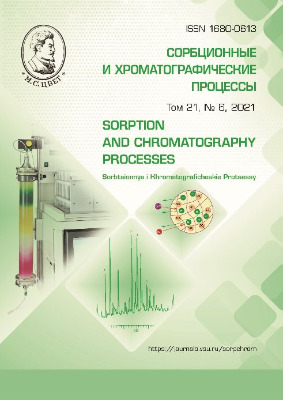The concept of gel diffusion in the kinetics of swelling and shrinking of a polystyrene sulfonic acid ion exchanger in the K+ form
Abstract
The kinetics of swelling and shrinking of polystyrene resins of the sulfonic acid type was investigated. The ion-exchange bead in the K+ form, equilibrated with a 0.1 M, 0.5 M, 1.0 M or 2 M KCl solution was placed into water and its diameter was measured continuously. In the reverse experiments, the bead, which came into equilibrium with water, was transferred into KCl solutions and the kinetics of grain shrinking was studied analogously. The experimental data were processed by using the theory of "gel diffusion", the parameter of which is the so-called gel diffusion coefficient, similar to the molecular diffusion coefficient. In contrast to previously published works, in which only the first term of the series in the corresponding equation was taken into account, in our work the first ten members of the series were taken into account. It turned out that it is necessary to take into account not only the first member of the series (as was done in previously published works), but also the second member of the series. It also turned out that the values of the obtained gel diffusion coefficient, obtained by this method, quite logically increased somewhat during the process of swelling (for example, in experiments with 1 M KCl from 2.1×10−6 to 3.0×10−6 cm2/s) and decreased somewhat during the process of shrinking. It was shown that the average values of the diffusion coefficients of the gel make it possible to adequately describe the main part of the kinetic curve. The concept of gel diffusion allows comparing the swelling kinetics of various polyelectrolyte gels in terms of diffusion coefficients, regardless of the particle shape, systematize data for various materials, and comparing their properties with the molecular diffusion of other substances.
It also turned out that in the very final parts (5-10%) of the kinetic curves a sharp decrease in the diffusion coefficient value was observed both in experiments with the swelling and shrinking of grains. It indicates that during the final stages there was a sharp deceleration of the process due to a change in its mechanism.
Downloads
References
Sainio T., Tiihonen J., Paatero E., Ion-exchange technology for today and tomorrow, Ed. by M. Cox. Churchill College, Cambridge, 2004, pp. 383-390.
Sainio T., Laatikainen M., Paatero E., Exchange and Solvent Extraction. A series of advances, SenGupta, A. (Ed.). Chapter 1, Vol. 18, CRC Press, Taylor and Francis Group, Boca Raton, London, New York, 2007, pp. 1-44.
Kudukhova I.G., Rudakov O.B., Ruda-kova L.V., Ferapontov N.B., Sorbtsionnye i khromatograficheskie protsessy, 2010, Vol. 10, No 4, pp. 589-594.
Rudakov O.B., Kudukhova I.G., Ruda-kova L.V., Pastukhov A.V. et al., Sorbtsionnye i khromatograficheskie protsessy, 2011, Vol. 11, No 6, pp. 880-886.
Ferapontov N.B., Tokmachev M.G., Ga-garin A.N., Gerasimchuk V.V. et al., Sorbtsionnye i khromatograficheskie protsessy, 2014, Vol. 14, No 5, pp. 795-812.
Karpyuk E.A., Titova O.I., Pastukhov A.V., Davankov V.A. et al., Solvent Extrac-tion and Ion Exchange, 2016, Vol. 34, No 4, pp. 362-374.
Vasheghani-Farahani E., Ganji F., Vasheghani-Farahani S., Iranian Polymer Journal, 2010, Vol. 19, No 5, pp. 375-398.
Peppas N.A., Advanced drug delivery reviews, 1993, Vol. 11, pp. 1-35.
Ritger P.L., Peppas N.A., J. Control. Release., 1987, No 5, pp. 23-26.
Ritger P.L., Peppas N.A., J. Control. Release, 1987, No 5, pp. 37-42.
Peppas N.A., Sahlin J.J., Int. J. Pharm., 1989, Vol. 57, No 2, pp. 169-172.
Crank J., The mathematics of diffu-sion, Second edition, 1975, Clarendon Press, Oxford, 1975, 414 p.
Boyd G.E., Adamson A.W., Myers L.S., J. Am. Chem. Soc., 1947, Vol. 69, No 11, pp. 2836-2848.
Kabra B.G., Akhtar M.K., Gehrke S.H., Polymer, 1992, Vol. 33, No 5, pp. 990-995.
Billovits G.F., Durning C.J., Chem. Eng. Commun., 1989, Vol. 82, No 1, pp. 21-44.
Tanaka T., Hocker L.O., Benedek G.B., J. Chem. Phys., 1973, Vol. 59, No 9, pp. 5151-5159.
Tanaka T., Fillmore D.J., J. Chem. Phys., 1979, Vol. 70, No 3, pp. 1214-1218.
Tanaka T., Sato E., Hirokawa Y., Hi-rotsu S. et al., Phys. Rev. Lett., 1985, Vol. 55, No 22, pp. 2455-2458.
Li Y., Tanaka T., J. Chem. Phys., 1990, Vol. 92, No 2, pp. 1365-1371.
Landau L.D., Lifshitz E.M. Theory of elasticity. 2nd ed., revised end enlarged, Per-gamon Press, 1970, 165 p.
Komori T., Sakamoto R., Colloid Polym. Sci., 1989, Vol. 267, No 2, pp. 179-183.
Ikkai F., Shibayama M., Journal of Polymer Science: Part B: Polymer Physics, 1996, Vol. 34, No 9, pp. 1637-1645.
Ivanov V.A., Karpyuk E.A., Shelkov-nikova L.A., Gavlina O.T., Sorbtsionnye i khromatograficheskie protsessy, 2016, Vol. 16, No 5, pp. 569-581.
Deriche R., Int. J. Computer Vision, 1987, Vol. 1, pp. 167-187.
Reid R.C., Prausnitz J.M., Sherwood T.K., The Properties of gases and liquids. 3rd edition, MacGraw Hill, New York, 1977, P. 11.30
Henrion P.N., Trans. Faraday Soc., 1964, Vol. 60, pp. 72-74.
Tong J., Anderson J.L., Biophysical J., 1996, Vol. 70, No 3, pp. 1505-1513.
Moller W.J., Proc. Natl. Acad. Sci. USA, 1964, Vol. 51, No 3, pp. 501-509.







